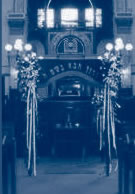|
SEDRA : TZAV Shabbat Zachor Hertz Chumash
p. 429 Leviticus Chap. 6
This week's Sedra is generously sponsored by Stephen Pinch.
SYNOPSIS
The daily OLAH - burnt offering was considered an atonement
for the whole nation. Its culmination occurred when the ashes
of the Olah were removed by the Kohanim. The fire upon the
altar was never to go out - which was interpreted as a lesson
of perpetual enthusiasm for learning and living according
to the Torah. From the day of his induction, the High Priest
was to bring a meal-offering, morning and evening, at his
own expense on behalf of the priesthood. Additional laws regarding
the duties of the Kohanim and the sacrifices are provided.
In particular those portions of the offerings to which the
Kohanim were entitled and the conditions regulating their
consumption are specified.
Mention is made of the prohibition of consuming blood and
CHELEV - certain fats forbidden to be eaten as they were reserved
for burning on the altar.
A description of the installation of Aaron and his sons as
Kohanim ensues. In an impressive ceremony in the Court of
the Sanctuary, Moshe, watched by those assembled, conducts
the ceremony : the Kohanim bathe; Moshe robes Aaron in his
Priestly garments; he anoints the Tabernacle, its vessels
and instruments. The anointing oil is then poured on Aaron's
head, Sanctifying him. Then the regular Kohanim are consecrated
and invested with their garments. Moshe brings a sin-offering
and a burnt offering. This ritual continues for seven days
during which Aaron and his sons, the Kohanim, remain in the
Court of the Sanctuary.
SPECIAL MAPHTIR Hertz Chumash P. 856, Deut 25, 17-19
The penultimate verse referring to Rosh Chodesh is repeated
again after the conclusion of the Haphtorah.
TELL ME RABBI ..... SHABBAT ZACHOR
Literally "Remember" occurs on the Shabbat before
Purim. The Torah commanded us always to remember the attack
which Amalek made upon Israel in the wilderness, a symbol
of the unprovoked hatred and of the blind and implacable enmity
which are the real cause of all suffering on earth. Therefore,
this section was ordained to be read on a special Shabbat
each year. The haphtorah of Zachor tells of the defeat of
Amalek by King Saul. Haman, one of the main figures in the
Purim story, is believed to be a descendant of Agag, King
of Amalek. It was thus found appropriate to read this paragraph
on the Shabbat preceding Purim. All generations are to blot
out the cruel spirit of Amalek from the human heart.
PURIM
Purim, observed on 14th Adar, commemorates the saving of
the Jewish communities living under Persian rule from Haman's
evil designs to exterminate them. It seems the events described
in the book of Esther, took place about 450 B.C.E. The name
Purim derives from the word pur - lottery, the method used
by Haman to select the date for a general massacre of the
Jews.
The sudden turn of events in the story of Purim which turned
the tables on the oppressor has provided a spark of hope and
encouragement to oppressed and victimised Jewish communities
throughout the centuries.
FOUR OBSERVANCES
* The most prominent observance of Purim is to listen to the
reading of the Scroll of Esther - the Megillah evening and
morning. Both men and women are required to listen to the
reading of the Megillah. Children should also be trained to
attend the Synagogue to fulfil this duty.
Purim observances are based on the following passages : "And
Mordechai wrote these things and sent letter to all the Jews
... to enjoin them that they should keep the fourteenth day
of the month of Adar as days of feasting and gladness, and
of sending portions one to another, and gifts to the poor.
And the Jews took upon themselves... and upon their descendants,
that they would keep these two days according to the writing
thereof and according to the appointed time, every year".
(Esther 9:20-23,27)
* A Festive family dinner Seudah should be held on Purim day
fulfilling the directive that these be days of feasting (y'mai
mishteh).
* Each person should "send portions" consisting
of at least two items of food that may be readily eaten to
several friends. This is called in Hebrew shalach manos or
mishloach manot.
* Each person should give gifts (charity) to at least two
poor people or worthy needy causes. Even a poor person who
is himself a recipient of charity must give to others. "A
person is required to drink on Purim until he does not know
the difference between `cursed be Haman' and `blessed be Mordechai'"
(Megillah 75). However one should not vulgarise his behaviour.
Although there is no prohibition of work on Purim one should
nonetheless abstain from one's regular job on Purim day (if
possible) and celebrate the holiday in the appropriate manner.
The custom to hold parades, carnival-type celebrations and
parties on Purim and the wearing of costumes and similar merrymaking,
especially by the children, is a particularly popular form
of Purim festivity.
BACK TO SHABBAT SHALOM
TABLE
|








